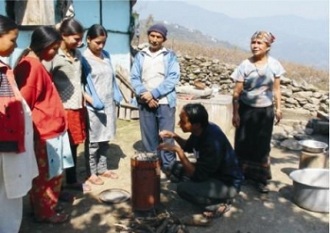Solar Cooker Review – March 2013
- Safe Water and Solar Cookers
- Solar vs Biomass Stoves
- George Clooney Part II
- ETHOS
- News You Send
- Solar Tech Talk (and A Cautionary Tale)
- Calendar of Events
- Annual Report
Public Consultation-Simplified Methodology for Improved Cookstoves | Source |
The Gold Standard “simplified methodology for efficient cookstoves” is now available for public comment on the PDF below.
This methodology aims to reduce the transaction costs for project developers while at the same time maintaining The Gold Standard level of robustness. We seek your valuable input to ensure the methodology is conservative, simple and widely applicable to project activities, whilst maintaining the highest level of environmental integrity. We are looking for specific inputs on:
- Defaults provided for ageing of stoves, baseline fuel consumption and wood emission factors etc.
- The different options given for determining the baseline fuel consumption
- Approach for determining the emissions from use of baseline stoves in the project scenario
- Monitoring approach given in the methodology including sampling guidelines
The deadline for comments is 30th March 2013 and all comments should be submitted to sriskandh@cdmgoldstandard.org. When providing comments please ensure you provide your name, organization, country and email address.
METHODOLOGY ABSTRACT:
The micro-scale methodology is for projects that introduce firewood based improved cookstoves. The methodology incorporates suppressed demand elements and is applicable to projects that reduce up to 10,000 tCO2 per year. To avoid resource intensive Kitchen Tests, this methodology provides defaults for aspects like ageing of stoves, emission factor of firewood and baseline fuel consumption etc. The methodology also includes simplified monitoring and provides guidance for user questionnaires.
- The Gold Standard Simplified Methodology for Efficient Cookstoves
- Annex A – Sample Survey Questionnaire
- For more information regarding The Gold Standard Suppressed Demand Methodologies and consultation process, please click here.
Ghanaian cookstoves entrepreneur Suraj Wahab shares his secrets | Source: Julia Hawkins, Ashden Digital and PR Manager, March 5, 2013
You know those days when everything clicks into place and you remember why you do what you do? Yesterday was one of those days. I had the pleasure of spending an hour or so with Suraj Wahab, CEO of Toyola Energy – a Ghanaian entrepreneur with a huge social conscience who was awarded the prestigous 2011 International Ashden Gold Award for his credit scheme for cleaner cookstoves. 
They say the best ideas are the simplest ones. Suraj’s model of ‘stoves made by the poor, sold by the poor and used by the poor’ couldn’t be more so. He trains people to produce and sell stoves to the poor, providing credit facilities in the form of the famous ‘Toyola Moneybox’ – no more sophisticated than a tin can with a slit cut in the top, to help them save up to pay back their loans.
“I learned business from my mother”, he told me. “I used to go selling fish from door to door when I was 10 years old, so that she could afford to send me to school. I learned from her that when you take your business to your customer – to their homes – you change the game. There are so many people with great ideas that just sit there, waiting for things to come to them. They’ll never make a successful business like that.”
PLoS One. 2013;8(2):e55670. doi: 10.1371/journal.pone.0055670.
Longitudinal Relationship between Personal CO and Personal PM2.5 among Women Cooking with Woodfired Cookstoves in Guatemala.
McCracken JP, Schwartz J, Diaz A, Bruce N, Smith KR.
Department of Environmental Health, Harvard School of Public Health, Boston, Massachusetts, United States of America.
Household air pollution (HAP) due to solid fuel use is a major public health threat in low-income countries. Most health effects are thought to be related to exposure to the fine particulate matter (PM) component of HAP, but it is currently impractical to measure personal exposure to PM in large studies. Carbon monoxide (CO) has been shown in cross-sectional analyses to be a reliable surrogate for particles<2.5 µm in diameter (PM) in kitchens where wood-burning cookfires are a dominant source, but it is unknown whether a similar PM-CO relationship exists for personal exposures longitudinally.
We repeatedly measured (216 measures, 116 women) 24-hour personal PM (median [IQR] = 0.11 [0.05, 0.21] mg/m) and CO (median [IQR] = 1.18 [0.50, 2.37] mg/m) among women cooking over open woodfires or chimney woodstoves in Guatemala. Pollution measures were natural-log transformed for analyses. In linear mixed effects models with random subject intercepts, we found that personal CO explained 78% of between-subject variance in personal PM. We did not see a difference in slope by stove type.
This work provides evidence that in settings where there is a dominant source of biomass combustion, repeated measures of personal CO can be used as a reliable surrogate for an individual’s PM exposure. This finding has important implications for the feasibility of reliably estimating long-term (months to years) PM exposure in large-scale epidemiological and intervention studies of HAP.
Environ Sci Technol. 2013 Mar 7.
Characterization of Ultrafine Particulate Matter from Traditional and Improved Biomass Cookstoves.
Just B, Rogak S, Kandlikar M.
Biomass combustion in cookstoves has a substantial impact on human health, affects CO2 levels in the atmosphere, and black carbon (BC) and organic carbon (OC) affect the earth’s radiative balance. Various initiatives propose to replace traditional fires with “improved” (non-traditional) cookstoves to offset negative local and global effects. In this laboratory study, we compared the size, composition, and morphology of ultrafine particulate emissions from a “three-stone” traditional fire to those from two improved stove designs (one “rocket,” one “gasifier”).
Measurement tools included a scanning mobility particle sizer, PTFE and quartz filter samples, and transmission electron microscopy. In the improved stoves, particulate mass (PM) emissions factors were much lower although median particle size was also lower: 35 nm and 24 nm for the rocket and gasifier, respectively, vs. 61 nm for the three-stone fire. Particles from improved stoves formed clearly defined chain agglomerates and independent spheres with little evidence of volatile matter and had a higher proportion of BC to total PM, although overall BC emissions factors were fairly uniform.
The three-fold increase in quantities of sub-30 nm particles from improved cookstoves warrants further consideration by health scientists, with due consideration to the higher combustion efficiencies of improved cookstoves.
Where There’s Smoke, There’s Fire: A Call to Action for Better Indoor Air Pollution Research | Source: Forbes, Feb 26, 2013 |
Editor’s note: Donn Tice is Chairman & Chief Executive Officer of d.light.
d.light is a for-profit social enterprise that designs, manufactures and distributes solar light and power products throughout the developing world, and aims to transform the lives of at least 100 million people by 2020. d.light serves over 40 countries through over 6,000 retail outlets, 10 field offices, and four regional hubs. The company employs over 200 people directly, and indirectly employs hundreds more worldwide. 
Good data—scientifically grounded, peer-reviewed and comprehensive—is essential to successful public policy and any serious attempt to solve social and economic development problems. The right blend of qualitative and quantitative inquiry can illuminate the scope and dimensions of a problem, uncover root causes, and reliably test whether alternative solutions actually work to produce lasting change in the real world.
Indoor air pollution (IAP) is an excellent example: A massive global problem and the second-largest driver of global warming, IAP causes over 3.5 million needless deaths each year, mainly in the developing world, and has a disproportionate impact on women and children. Indoor air pollution has been the focus of good research – up to a point.
The State of the Art
One of the most trusted sources of data-driven guidance for global health policy makers and practitioners is the “Global Burden of Disease” (GBD) report. The latest report was published in December 2012 in The Lancet. The largest, most well respected, and best-funded study of its kind in the world, the GBD is an extraordinary collaboration based on the combined research of over 400 scientists in more than 300 institutions in 50 countries.
Ambient particulate air pollution and acute lower respiratory infections: a systematic review and implications for estimating the global burden of disease. Air Qual Atmos Health. 2013 Mar;6(1):69-83.
Mehta S, Shin H, Burnett R, North T, Cohen AJ. Health Effects Institute, 101 Federal Street, Suite 500, Boston, MA 02110 USA.
Acute lower respiratory infections (ALRI) account for nearly one fifth of mortality in young children worldwide and have been associated with exposures to indoor and outdoor sources of combustion-derived air pollution. A systematic review was conducted to identify relevant articles on air pollution and ALRI in children. Using a Bayesian approach to meta-analysis, a summary estimate of 1.12 (1.03, 1.30) increased risk in ALRI occurrence per 10 μg/m3 increase in annual average PM2.5 concentration was derived from the longer-term (subchronic and chronic) effects studies.
This analysis strengthens the evidence for a causal relationship between exposure to PM2.5 and the occurrence of ALRI and provides a basis for estimating the global attributable burden of mortality due to ALRI that is not influenced by the wide variation in regional case fatality rates. Most studies, however, have been conducted in settings with relatively low levels of PM2.5.
Extrapolating their results to other, more polluted, regions will require a model that is informed by evidence from studies of the effects on ALRI of exposure to PM2.5 from other combustion sources, such as secondhand smoke and household solid fuel use.
Household air pollution: a call for studies into biomarkers of exposure and predictors of respiratory disease. AJP – Lung Physiol March 1, 2013 ajplung.00416.2012
Jamie Rylance, et al.
Household air pollution (HAP) from indoor burning of biomass or coal is a leading global cause of morbidity and mortality, mostly due to its association with acute respiratory infection in children, chronic respiratory and cardiovascular diseases in adults. Interventions that have significantly reduced exposure to HAP improve health outcomes and may reduce mortality.
However, we lack robust, specific and field-ready biomarkers to identify populations at greatest risk, and to monitor the effectiveness of interventions. New scientific approaches are urgently needed to develop biomarkers of human exposure that accurately reflect exposure or effect.
In this perspective, we describe the global need for such biomarkers, the aims of biomarker development, and the state of development of tests which have the potential for rapid transition from laboratory bench to field use.
Implications of Charcoal Briquette Produced by Local Communities on Livelihoods and Environment in Nairobi Kenya. Int. Journal of Renewable Energy Development 2 (1) 2013: 19-29.
Mary Njenga, et al
The residents of Nairobi, Kenya, use 700 tonnes of charcoal per day, producing about 88 tonnes of charcoal dust that is found in most of the charcoal retailing stalls that is disposed of in water drainage systems or in black garbage heaps. The high costs of cooking fuel results in poor households using unhealthy materials such as plastic waste. Further, poor households are opting to cook foods that take a short time to prepare irrespective of their nutritional value.
This article presents experiences with community self-help groups producing charcoal fuel briquettes from charcoal dust in poorer nieghbourhoods of Nairobi for home use and sale. Households that produced charcoal fuel briquettes for own use and those that bought them saved 70% and 30% of money spent on cooking energy respectively. The charcoal fuel briquettes have been found to be environmentally beneficial since they produce less smoke and increase total cooking energy by more than 15%, thereby saving an equivalent volume of trees that would be cut down for charcoal.
Charcoal briquette production is a viable opportunity for good quality and affordable cooking fuel. Bioenergy and waste management initiatives should promote recovery of organic by-products for charcoal briquette production.




